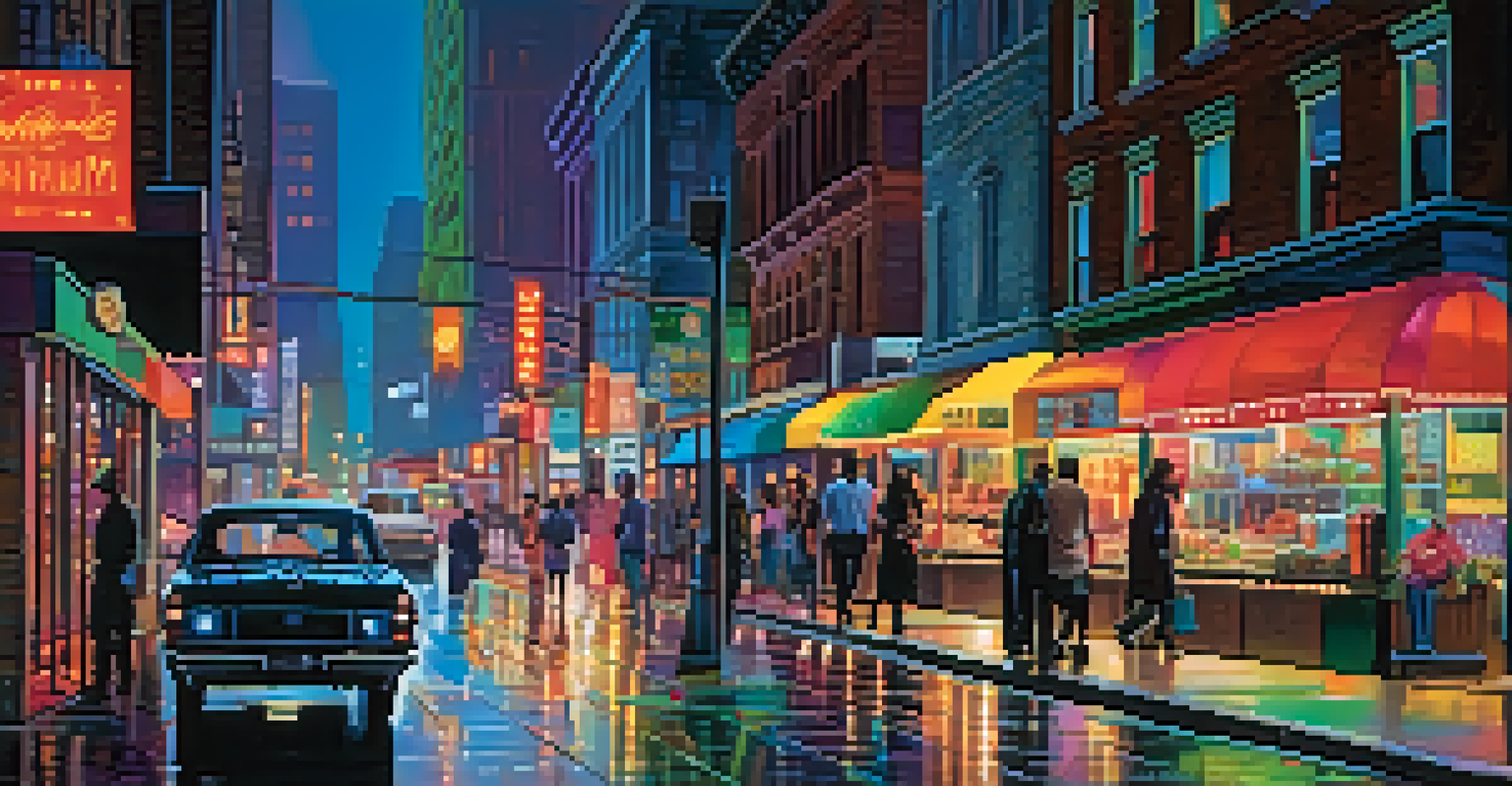The Impact of 4K and 8K Resolution on Filmmaking Standards

Understanding 4K and 8K Resolutions in Filmmaking
When we talk about 4K and 8K resolutions, we're diving into the world of pixels. 4K, which has a resolution of 3840 x 2160 pixels, offers four times the detail of 1080p HD. On the other hand, 8K pushes the envelope even further with a staggering 7680 x 4320 pixels, delivering sixteen times the detail of standard HD. This increase in resolution doesn't just make images sharper; it enhances the overall visual storytelling experience.
The future of filmmaking will be shaped by the interplay between technology and creativity.
The difference in clarity between these resolutions can be likened to the difference between peering through a foggy window and a crystal-clear one. In a foggy view, you miss the finer details, while a clear view allows you to see nuances, textures, and colors that tell a richer story. For filmmakers, this means they can capture and convey emotions in ways that were previously unattainable.
However, the adoption of 4K and 8K isn't just about clarity; it also raises expectations. Audiences have become accustomed to high-quality visuals, and filmmakers must now meet these new standards to keep viewers engaged. This evolution in expectations is transforming the industry landscape, pushing creatives to innovate and adapt.
The Influence of Resolution on Cinematic Techniques
Higher resolutions like 4K and 8K influence various cinematic techniques, from camera angles to lighting. For instance, filmmakers can now employ more intricate camera movements without losing quality. This is especially important for dynamic scenes, where precision can make or break the audience's experience. It opens up new possibilities for storytelling that were previously limited by lower resolutions.

Moreover, lighting techniques have also evolved. With the ability to capture finer details, filmmakers can experiment with subtler lighting that enhances mood and atmosphere. For example, shadows and highlights can be manipulated more effectively, allowing for a more immersive viewing experience.
4K and 8K Enhance Visual Storytelling
Higher resolutions provide filmmakers with the ability to capture finer details, enriching the emotional depth and clarity of their narratives.
Additionally, the use of depth of field has transformed. Filmmakers can achieve a shallower depth of field, creating stunning backgrounds that draw viewers into the story. This technique not only elevates the visual experience but also emphasizes character emotions and interactions, making every frame a work of art.
The Role of Post-Production in Higher Resolutions
Post-production has become a pivotal stage in the filmmaking process, especially with the introduction of 4K and 8K resolutions. Editors now have access to an abundance of detail, allowing for a more precise editing process. They can zoom in on footage without sacrificing image quality, making it easier to refine each scene to perfection.
Higher resolutions not only enhance the visual experience but also elevate storytelling to new heights.
Color grading is another area that benefits significantly from higher resolutions. With more data to work with, colorists can achieve richer and more vibrant palettes. This adds depth and nuance to the visual storytelling, enhancing the emotional impact of the film and creating a more captivating experience for the audience.
However, this increased detail comes with challenges, such as longer rendering times and the need for more robust editing equipment. Filmmakers must invest in advanced technology to handle these larger files, which can be a daunting hurdle, especially for independent filmmakers. Yet, those who adapt reap the rewards of superior visual storytelling.
Audience Expectations and Experience with 4K and 8K
As 4K and 8K content becomes more prevalent, audience expectations have shifted dramatically. Viewers now anticipate a certain level of quality when they sit down to watch a film or series. This has created a new standard that filmmakers must meet to attract and retain audiences, pushing them to invest in high-quality production techniques.
Moreover, the experience of watching films at these resolutions is markedly different. The visual clarity and detail immerse viewers in the story, making it feel more real and engaging. For example, a scenic landscape shot in 8K can transport viewers directly into the setting, evoking emotions and reactions that enhance their connection to the narrative.
Audience Expectations Have Shifted
With the prevalence of 4K and 8K content, viewers now demand higher quality visuals, prompting filmmakers to invest in advanced production techniques.
This shift in audience expectations also influences streaming platforms and cinemas, which are now prioritizing higher-resolution content. As a result, filmmakers are encouraged to create visually stunning works that meet these new demands, ensuring their films stand out in an ever-competitive market.
The Cost of Producing 4K and 8K Content
While the benefits of producing in 4K and 8K are clear, the costs associated with this high-resolution content can be daunting. Filmmakers must invest in advanced cameras, lenses, and storage solutions to handle the larger file sizes. This can significantly increase production budgets, making it a challenging prospect for smaller productions.
In addition to equipment costs, the need for skilled professionals who can work with this technology adds another layer of expense. From cinematographers to editors, the demand for expertise in high-resolution filmmaking is growing, which can drive up labor costs. It's a balancing act that filmmakers must navigate as they strive to produce high-quality content.
Despite these challenges, many believe the investment is worth it. As audiences continue to gravitate towards high-definition content, the potential for greater viewership and engagement becomes a compelling reason for filmmakers to embrace these new standards. The return on investment can be significant, paving the way for future projects that push creative boundaries.
Emerging Technologies and Their Impact on Filmmaking
As the film industry embraces 4K and 8K resolutions, emerging technologies play a crucial role in shaping the future of filmmaking. Innovations like virtual reality and augmented reality are becoming more integrated with traditional filmmaking, offering filmmakers new tools to tell their stories. These technologies often rely on high resolutions to create immersive experiences that captivate audiences.
For instance, virtual reality films require stunning visuals to transport viewers into entirely different worlds. The clarity provided by 4K and 8K resolutions enhances this experience, making it feel more realistic and engaging. This opens up a new frontier for filmmakers, allowing them to experiment with storytelling techniques that were previously unimaginable.
Emerging Tech Transforms Filmmaking
Innovations like virtual reality and AI are reshaping storytelling possibilities, allowing filmmakers to create immersive experiences that leverage high resolutions.
Moreover, advancements in AI and machine learning are also influencing how films are produced. These technologies can assist in various aspects, from script analysis to post-production editing, streamlining workflows and enhancing the creative process. As filmmakers continue to embrace these innovations, the possibilities for storytelling in higher resolutions are truly limitless.
The Future of Filmmaking: 4K, 8K, and Beyond
Looking ahead, it's clear that 4K and 8K resolutions are not just trends; they signify a fundamental shift in filmmaking standards. As technology continues to evolve, we might soon witness even higher resolutions and improved visual capabilities. This constant innovation will likely push filmmakers to adapt and redefine their artistic approaches to storytelling.
Moreover, the rise of 8K content may inspire filmmakers to explore new narratives and styles that take full advantage of this clarity. We could see a surge in projects that prioritize visual grandeur, challenging traditional storytelling methods. This evolution could lead to a more diverse range of films that provide audiences with unique experiences.

Ultimately, the future of filmmaking will be shaped by the interplay between technology and creativity. As filmmakers harness the potential of high resolutions, they will continue to redefine what is possible in visual storytelling, creating cinematic experiences that resonate deeply with audiences for years to come.